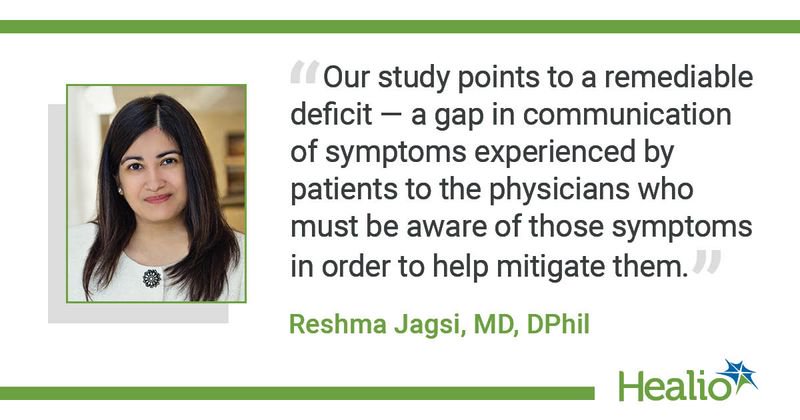Physicians may miss key symptoms in patients with breast cancer undergoing radiotherapy
Physicians may overlook substantial symptoms in certain patients undergoing radiotherapy for breast cancer, especially those who are young, Black or of “other” race or ethnicity, according to a study published in JAMA Oncology.
“Our study points to a remediable deficit — a gap in communication of symptoms experienced by patients to the physicians who must be aware of those symptoms in order to help mitigate them,” lead author Reshma Jagsi, MD, DPhil, deputy chair of radiation oncology and Newman Family Professor of Radiation Oncology at University of Michigan, told Healio. “Because this deficit is more pronounced in racial and ethnic minority patients, this is not only a target for general quality improvement, but also for mitigation of disparities in oncology care.”

Jagsi spoke with Healio about the study’s findings and how to overcome communication gaps and improve symptom detection.
Healio: What inspired you to study the underrecognition of symptoms among patients undergoing breast radiotherapy?
Jagsi: Prior studies, including one relating to the gastrointestinal toxicity of radiation treatment, had suggested that physicians may underrecognize symptoms that trouble their patients and that patient-reported outcome measures are more likely to reveal serious toxicity than provider reports. This led us to study this in the context of breast radiotherapy.
Healio: What led you to hypothesize that there might be racial disparities associated with this underrecognition?
Jagsi: Our prior work showed that racial minority patients had higher rates of symptoms during breast radiotherapy, so we hypothesized that inadequate communication and recognition of symptoms, with the ensuing inability to provide adequate supportive care, might be one mechanism driving that difference in patient experiences. Other studies have shown clinicians may be less sensitive to pain Black patients experience and less likely to prescribe them pain medication. Also, skin reactions to radiation may be less easily observed in patients with darker skin pigmentation. These are among the reasons why we hypothesized that underrecognition of symptoms would be more likely for patients of minority race or ethnicity.
Healio: What did your study find in terms of how well Common Toxicity Criteria for Adverse Events (CTCAE) could identify symptoms of adverse events in women undergoing breast radiotherapy?
Jagsi: Over half of all patients who experienced a significant acute toxicity symptom based on their own report in this study did not have timely recognition of that symptom by their physician as recorded using the CTCAE.
Healio: Why do you think CTCAE assessment seems to miss symptoms in certain patients, such as those who are younger or Black?
Jagsi: It may be that physicians are particularly vigilant of toxicity in older adults or in patients whose skin more readily shows the radiation reaction through erythema. It is also possible that certain patients’ prior experiences with the health care system impede communication. If I went to the dentist with severe pain many times and never got appropriate pain medication, as is the case for many Black patients, maybe I wouldn’t go out of my way to tell my next physician about symptoms because the health care system had clearly not been trustworthy or helpful for me.
Healio: How do patient-reported outcomes provide a clearer, more accurate representation of adverse events among these patients vs. CTCAE assessments?
Jagsi: Patient-reported outcomes are powerful tools for detecting symptoms that might be missed, especially in busy or underresourced clinical settings. The patient’s own report is quite simply the gold standard when assessing whether and how often a symptom is bothering them.
Healio: What do you think should be done differently in light of these findings?
Jagsi: The trustworthiness of the health care system begins with scrutinizing our own behaviors as care providers, reflecting on how certain approaches may exacerbate disparities, and listening to those from marginalized populations to understand how best to mitigate challenges to the equitable delivery of high-quality care. Recognizing the value of interdisciplinary care teams, promoting engagement of nursing and other support staff, and optimizing communication within these teams regarding symptom identification and supportive care delivery is a promising approach to guide future interventions in this regard.
Healio: What is next in your research on this topic?
Jagsi: We will continue in our collaborative quality initiative — Michigan Radiation Oncology Quality Consortium — to partner across the state with other radiation oncology practices to develop innovative interventions to improve communication and care delivery, measure their impact and disseminate our findings.
For more information:
Reshma Jagsi, MD, DPhil, can be reached at rjagsi@med.umich.edu.
